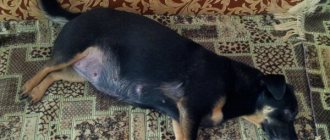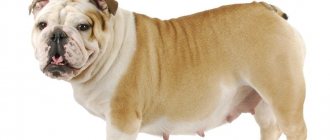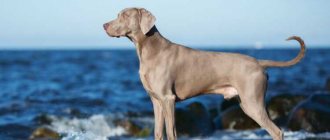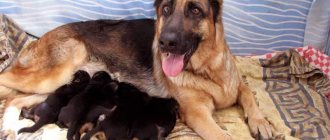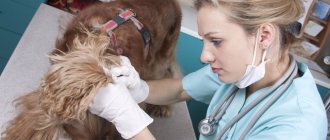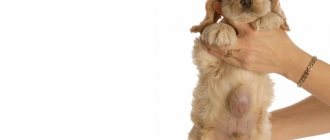Preparing for the birth of a dog at home
A dog's pregnancy lasts approximately 63 days (range 57 to 68 days) , depending on the breed and size of the female. The period is calculated from the day of the first insemination. Approximately two weeks before giving birth, the animal experiences changes in behavior as the dog begins to prepare for the birth of puppies.
The owner should also prepare in about the same two weeks. Ideally, pregnancy and childbirth take place under the supervision of a veterinarian, but if it is impossible to contact a specialist, the dog owner must take care of his pet himself.
First of all, you need to take care of your future offspring. It is necessary to build (or buy) a special pen in which the mother will be with the puppies:
- The design of the playpen is simple and consists mainly of 4 sides, which will prevent growing puppies from spreading out.
- The height of the sides depends on the size of the dog - they should be high enough so that the puppy cannot crawl over it, but the female can get out freely and without difficulty.
- On the inside of the sides it is necessary to nail solid shelves along the entire perimeter of the pen - its height also depends on the size of the dog. This shelf is needed so that the mother does not crush the puppy when she lies down (this is especially true for large dogs) - the puppy can crawl to the side and the mother may not notice him and crush him with her body.
Immediately before giving birth, you need to cover the playpen with a warm cover and clean diapers, and also prepare a few more items:
- Clean towels – dry the puppies. The more puppies, the more dry towels there should be.
- Scales and a notebook where the weight of the puppies at birth will be recorded, so that later you can monitor the weight gain of the babies.
- Clean water should always be available when the dog wants to drink, it should not get up and the bowl of water should be close.
- Sterile gloves in case you have to help your dog give birth.
- Oxytocin to stimulate contractions (but strictly as prescribed by a doctor and under supervision). Stimulation can lead to very sad consequences if it is carried out at the wrong time or injected in excessive quantities.
We measure the animal's temperature before giving birth
The normal body temperature of a dog depends on the size of the dog and ranges from 37.5 to 39 degrees . The larger the dog, the lower its body temperature. For a German shepherd, 37.8 - 38.0 is a normal temperature; for miniature dogs, 39 is also normal.
The main, but not the only, sign of the onset of labor is a decrease in body temperature by about 1 degree. The temperature drops approximately 12-24 hours before the first contractions appear.
Body temperature must be measured rectally . To do this, the dog is laid on its side. The tail is moved back, the tip of the thermometer is lubricated with oil or Vaseline and inserted into the anus approximately 1-1.5 cm . If the thermometer is electronic, then you need to remove the thermometer after the sound signal; a simple mercury thermometer is removed after 1.5-2 minutes .
You can also measure body temperature in a standing position if the dog does not resist: the animal is fixed in one position, the tail is moved back, then the same manipulations are performed.
If the birth is premature
Premature birth always indicates some pathology in the development of the fetus or a disease in the dog. Therefore, if labor begins prematurely, you need to immediately bring the dog to the veterinarian or call him at home: the risk of losing not only the puppies, but also the mother dog is very high.
When labor begins, you first need to calm the dog down by stroking its sides . If you absolutely need to save the puppies, you cannot do without veterinary care and a caesarean section - because... The dog's body is not prepared for childbirth, contractions may begin later or be too weak, and the puppies may die from suffocation.
Under no circumstances should labor be interrupted! This threatens the death of not only the puppies, but also the dog.
What will you need?
As soon as you find out that your pet will soon give birth, and cubs will appear in the house, you should start preparing, since keeping a whelped bitch and small animals requires proper care and many additional equipment:
- Maternity place . Usually this is a large box with a tight bottom and sides, in which a mother and children can easily fit. You can make it yourself, or you can buy a special box at a pet store. It is necessary to purchase it in advance so that the bitch can get used to it and feel safe.
- A supply of newspapers and bedding that will need to be changed at least once after childbirth.
- Warmer.
- Electronic balance.
- Bitch milk substitute.
Stages of labor
Childbirth is a complex process that takes place in several stages.
Contractions
Before contractions occur, the cervix dilates. There may be discharge from the loop, uterine contractions or contractions may occur. Contractions can begin several hours before birth (up to 12 hours) .
When the amniotic fluid breaks, labor itself begins. The contractions are accompanied by pushing or contraction of the abdominal muscles. After pushing begins, the puppies begin to move along the birth canal.
The process of giving birth to puppies
No more than 4 hours should pass from the moment of pushing until the puppy appears . Puppies are born at short intervals - approximately 5-20 minutes . But the break in the appearance of puppies can last up to 2 hours . If the interval between the appearance of puppies is longer than 2 hours, you should contact a veterinarian.
Normally, labor lasts from 6 to 8 hours, less often – up to 12 hours.
As soon as the puppy is born, and the mother has gnawed the umbilical cord and licked the baby, it needs to be attached to the nipples - this stimulates the release of milk. Colostrum is very beneficial for newborn puppies, and when he sucks on the nipple, the dog calms down and the birth will go faster.
Umbilical cord and placenta
After the puppy is born, after about 10-15 minutes the placenta appears . The afterbirth should not have an unpleasant odor. If the afterbirth smells unpleasant or is green in color, you should never give it to the dog and you should contact your veterinarian: an unpleasant odor or green color indicates inflammation.
The placenta may not come out after each puppy, but several at once, after the birth of 2-3 puppies.
If the afterbirth does not have an unpleasant odor, it can be given to the dog, but no more than two pieces. Eating the placenta is important for the female - it contains many hormones that stimulate milk production and calm the dog.
If the dog itself does not care for the newborn puppy, you need to carefully wipe the puppy with a towel, and tie the umbilical cord with a silk thread and cut it at a distance of about 2 cm from the puppy’s tummy (the thread should be in the middle - between the tummy and the cut).
Breathing problems - norms and pathologies
Within a few hours after giving birth, the new mother feels very tired. Against the backdrop of a likely refusal to eat, the degree of fatigue only gets worse. In addition, the young mother experiences significant discomfort. Against the background of painful sensations in the abdomen, puppies sucking milk can provoke hot flashes. In this case, the dog begins to breathe with its mouth open.
Note! When puppies suckle, they stimulate the uterus to cleanse and contract, which can cause additional tension in the peritoneum. During contractions, the dog may breathe heavily - this is normal.
The owner should immediately contact a veterinarian if breathing problems lead to obvious oxygen deprivation. Intense breathing with an open mouth can be triggered by an increase in base body temperature. Unfortunately, fever in the postpartum period indicates serious complications: the development of an inflammatory process, an infectious lesion or postpartum eclampsia.
Postpartum dog care
Postnatal care includes weighing the puppies . They need to be placed in a playpen (or box), where the bitch should then be placed. If the puppies cannot find the nipples, you need to carefully “plant” the puppy on the free nipple.
The mother dog needs to be given something to drink (if she wants to drink) and left alone - she needs rest. She will take care of the offspring herself.
Taking your temperature after childbirth
After birth, the dog's body temperature evens out. After the last placenta is released, you need to measure the dog’s body temperature. The measurement method is no different from that used before birth. Body temperature should return to normal.
What to feed your mother dog
The dog's diet should not differ from what it had during pregnancy. Portions should also be left in the amount that the dog ate in the last week of pregnancy; if there are a lot of puppies, the amount of food can be increased, but the dog should not overeat.
It is important to add calcium and phosphorus, vitamins and supplements to your dog's food for bone development. Puppies take all the calcium and many microelements from their mother with milk - all this needs to be replenished with additional vitamins.
Discharge in a dog after childbirth
Normal discharge from the loop can last up to 3 weeks after birth . If the discharge does not emit an unpleasant putrid odor or is not green (dark green) in color, then you just need to watch the dog.
If the discharge smells unpleasant or looks suspicious, you need to urgently take the dog to the doctor - perhaps it is going through an inflammatory process, and such a condition can not only harm the dog, but also the puppies through milk.
Eclampsia - as a possible postpartum problem in a bitch
Due to a sharp change in hormonal levels, a lack of calcium and glucose in the body, a dog can develop a postpartum coma - eclampsia.
This condition can appear a few hours after the start of lactation or after a few days or even weeks, at any stage of feeding.
Eclampsia threatens the dog’s life, so if the dog has shortness of breath, heavy breathing, rapid pulse, depression or paralysis of the paws, if the dog refuses to eat and is trembling, you should urgently take the female to the doctor. Self-medication or ignoring symptoms leads to the death of the animal .
Posts 1 page 22 of 22
Share12008-12-13 17:26:38
- Author: Hase
- Forum Administrator
- From: Karlsruhe.Deutschland.
- Registered: 2008-12-11
- Invitations: 4
- Posts: 11210
- Female gender
- My pets: American cocker-spaniel,deutscher Zwergspitz
- Spent on the forum: 4 months 21 days
- Last visit: 2019-10-02 20:11:16
My bitch Chara (Bernese Mountain Dog) had 10 puppies. She fed them entirely on her own milk for 2 weeks, during which time I fed her 6-7 times a day during nursing. She nursed until (almost) 2 months. She became very thin, her fur became coarse and greasy, and shed a lot. Now under the skin there seems to be fat and sufficient muscle mass, but the appearance: thin legs, translucent fur. The question is: how can I help my dog recover?
Share22008-12-13 17:26:47
- Author: Hase
- Forum Administrator
- From: Karlsruhe.Deutschland.
- Registered: 2008-12-11
- Invitations: 4
- Posts: 11210
- Female gender
- My pets: American cocker-spaniel,deutscher Zwergspitz
- Spent on the forum: 4 months 21 days
- Last visit: 2019-10-02 20:11:16
erofey You can speed up your dog’s recovery process by taking a course of Gamavit injections with catozal and introducing calcium supplements into the diet. And of course, good nutrition, rich in protein.
Share32008-12-13 17:27:09
- Author: Hase
- Forum Administrator
- From: Karlsruhe.Deutschland.
- Registered: 2008-12-11
- Invitations: 4
- Posts: 11210
- Female gender
- My pets: American cocker-spaniel,deutscher Zwergspitz
- Spent on the forum: 4 months 21 days
- Last visit: 2019-10-02 20:11:16
In addition to Gamavit, you can try nucleopeptide. I quote from the abstract: Used to increase the body’s resistance to diseases, as well as improve the growth and development of animals. To increase muscle mass, for exhibition animals to improve coat quality. In stressful situations, before exhibitions.
General advice for the owner of a dog giving birth
- You need to prepare for childbirth with responsibility and attention - this is stress for the dog’s body. It is better if everything takes place under the supervision of a veterinarian or a person who has experience in obstetrics.
- For a dog, childbirth is a lot of stress, especially for first-time dogs. The dog owner can help the pet, calm it down with affection and stroking.
Attentive attitude towards your pet is the main help that a dog owner can provide. In other cases, only a veterinarian will help, because in a matter such as childbirth, unqualified intervention can cost not only the health of the puppies, but also the life of the mother dog.
3 / 5 ( 3 voices)
Veterinary examination
I hope there is no need to convince you, dear readers, of the need for regular veterinary examinations. In general, a healthy and active animal should be shown to the veterinarian at least once a year, at least in order to undergo a course of preventive vaccinations.
Dogs in a “special” condition (puppies, elderly, sick, injured, weakened) need more care. Pregnancy is not a disease, of course. But during this period you should be especially attentive to the dog’s condition and the slightest changes in it. Of course, there is no need to take your dog to the clinic every day. But the veterinarian must examine the expectant mother a couple of times to make sure that everything is going well. The doctor’s phone number should be at your fingertips during childbirth (and if you have no experience at all in this matter, it is better to call a veterinarian at home when the process begins).
It is important to show the dog and puppies to a specialist in the first month of the puppies’ life.
Dancing Doberman disease
This neurological syndrome is characterized by flexion of one hind limb while standing. Over time, the second hind limb is affected. A sick dog bends and extends its limbs alternately, as if in a dance. It is assumed that there is a combined response to a sensory stimulus and an automatic neurological impulse. The disease occurs in Doberman Pinschers between 6 months and 7 years of age and affects both males and females. September 14, 2012
Symptoms and types
The main symptom is the bent position of one paw while standing. The second limb is usually affected after 3-6 months. When a dog changes its paws, it appears as if it is dancing. The animal cannot control it. Soon after the onset of the disease, these overactive tendon reflexes lead to progressive muscle atrophy of the limbs. Sometimes the muscles of the limbs lose the ability to respond to the dog's desire to move. This is called proprioceptive deficit.
Causes
The cause of this disease is unknown, but it is believed to be inherited recessively.
Diagnostics
Other conditions associated with Dancing Doberman disease may include lumbosacral stenosis (a narrowing of the lower part of the spinal canal that compresses the nerve roots) or an infection of one or more bones in the spine or the intervertebral discs that connect them in the lumbar region (intervertebral disc disease and discospondylitis, respectively). Dancing Doberman disease is usually painful. A veterinarian can also diagnose cancer of the lumbar spinal cord or nerve endings. This condition progresses quickly and can be painful.
Diagnostic procedures include electromyography (recording the electrical activity of muscles) and testing the amount of uncontrolled muscles and nerves (fibrillation). The veterinarian examines the transmission of information from sensory to motor centers (nerve conduction velocity) to determine the severity of the disease. He will also take a sample of muscle tissue behind the knee joints to examine for muscle disease and/or nerve damage.
Treatment
There are no methods to control the clinical symptoms of this disease or slow its progression.
After that
Several patients were followed for five years or more and remained acceptable pets.
Determination of gender
An experienced veterinarian will be able to accurately determine the sex within a week after birth. Everyone else will have to wait a little longer until the genitals become more visible.
Males and females are distinguished by the structure of the genital organs and behavioral characteristics, so after 8-10 weeks there will be no problems with sex determination. Boys will already have clearly visible penises, while girls will have a fully formed vulva. However, if you cannot wait that long, the determination can be made earlier, at about 1 month.
Inspection is carried out in compliance with safety precautions:
- Wash and dry your hands thoroughly and warm them.
- Take the puppy and observe the mother's reaction. If she objects aggressively, it is better to carry out the procedure later.
- Gently turn the dog over onto his back. If the puppies are large, then it is better to carry out the operation on a warm towel; if they are small, then it is possible to carry out the operation by weight in the palm of your hand.
- Pay attention to the genital area. Representatives of both sexes have one bulge - the umbilical cord, but just below there will be either a developing penis, which looks like a small seal and tubercle, or a vulva, that is, a second hole.
The easiest way to distinguish newborns is by the number of holes in the lower abdomen. Boys have one, and girls have two.
Preventive actions
Owners of puppies should accustom their puppies to high-quality food from the first days. You cannot deprive your pet of vitamin B1 and animal proteins. It is necessary to completely exclude salted foods from the diet of a dog with heart problems.
It is equally important to maintain an optimal microclimate in the room where your pet is kept: ventilate daily, humidify the air, wipe off dust, and wash the floors.
You shouldn’t let your four-legged friend become overtired during training. It is contraindicated to expose to unnecessary emotional stress. Compliance with routine immunization will save you from infectious diseases and their unpleasant consequences.
It is unlikely that you will be able to completely get rid of asthmatic attacks. But with the right approach, they can be effectively stopped. This will enable the four-legged patient not to experience much discomfort from his illness.
Dogs are emotional animals that can make many different sounds. They bark, howl, whine, squeal, growl, expressing their emotions. At the same time, many dogs snore in their sleep, and after waking up the dog may grunt and sneeze. In some cases, such sounds are caused by the anatomical structure of the nasopharynx and the physiological characteristics of the body. But what to do if the dog is choking, sneezing, coughing, grunting, breathing heavily and intermittently?
When is a visit to the vet necessary?
A visit to a canine doctor is required for animals with the following clinical signs:
When visiting the clinic, your pet will undergo a full examination and diagnostic examination, which will help to understand the cause of the deviation. Identifying diseases at the primary stages of development gives a better chance of recovery. Ignoring obvious symptoms will lead to the pathology becoming chronic, and in worst cases, to the death of the animal.
It is impossible to accurately determine the source of muscle contractions in a pet without diagnostics - the doctor is based not only on visual examination data, but also on the results of laboratory tests. Many owners make the mistake of mistaking pathology for physiological manifestations, wasting precious minutes.
Breed Features
In some cases, rapid breathing is the norm, as it is inherent in a given breed of dog, such as Labrador, Spitz, etc. Let's look at some of them. The Shih Tzu has a flat face, and that is why it breathes differently in different cases, for example:
- Snort. Appears during exhalation when there is discharge in the nose.
- Reverse sneezing is a hum-like sound. They are the norm.
Read Dog distemper vaccination schedule: vaccination calendar Another representative of unusual breathing is the pug. They have a rather short palate, which makes their breathing difficult. Because of this feature, they may snore during sleep.
The Spitz is a representative of a certain type of cough. Due to the peculiar structure of the larynx, the closedness of the cartilaginous tissues, during stressful situations, as well as illness, they develop a cough and their breathing changes, it becomes peculiar, it seems to us that the animal is sneezing, but this is not the case.
Pekingese have a very short nasal passage, which makes breathing difficult for them. Due to the peculiar structure of the larynx, a dog may stop breathing during sleep, so it is not advisable for the dog to sleep on its back. In addition, the animal often snores during sleep.
[custom_ads_shortcode2]
Cough, wheezing, regurgitation of white foam due to lungworms
When a dog simultaneously coughs, regurgitates white foam and wheezes, this may indicate a helminthic infestation. Parasites can easily move throughout the host’s body, including the esophagus.
When there are too many worms, they can reach the dog's throat, as a result of which he tries to free himself from foreign bodies by coughing and regurgitating. Parasitic larvae can live in a dog's lungs, these are so-called lungworms. In addition to coughing, secretion of white foam and wheezing, when it is infected with helminths, there is an appetite disorder, drowsiness, the coat changes, and blood can be released in the feces.
Worms can be of different types:
- Toxocara and roundworms, which cause toxocariasis and ascariasis;
- Cucumber tapeworm, which causes dipylidia. The dog is worried about intestinal obstruction and itching in the anus;
- Esophageal esophageal worms in dogs are accompanied by coughing and wheezing, vomiting and problems with swallowing food.
Coughing, wheezing and regurgitation are quite common syndromes of a wide range of diseases in dogs, which, even in their entirety, cannot accurately indicate the existing problems. Therefore, it is very difficult to make a diagnosis based on these signs alone. Only an experienced veterinarian can tell why a dog is coughing, as if he was choking, for several days after conducting an appropriate examination. The pet is prescribed tests, examining the upper respiratory tract and pharyngeal area.
Treatment of complications
First, a complete diagnosis is carried out at the veterinary clinic. The first thing doctors must make sure is that there is no placenta or puppy in the uterus, as well as ruptures. In case of bleeding due to atony or prolonged tissue repair, drugs that stimulate contraction of the organ are prescribed. This is Oxytocin. Additionally, a special massage is performed to help the discharge of discharge and provoke the return of the uterus to its normal state.
The infection is treated with antibiotics. Only a doctor prescribes the dosage and medication, otherwise you can harm your pet.
Necrosis, incomplete cleansing of the uterus, and rupture require surgical intervention. Surgery is scheduled immediately to save the dog's life.
For bleeding, the following drugs are used:
- Intravenous solution of stipticine 2-5%;
- Adrenaline 0.1%;
- Calcium chloride 10%.
Metritis is treated with antibiotics in accordance with calculations based on the animal’s weight, as well as intravenous infusion of saline.
Sometimes doctors have to remove the uterus, and in case of acute infection, remove the mother from breastfeeding.

